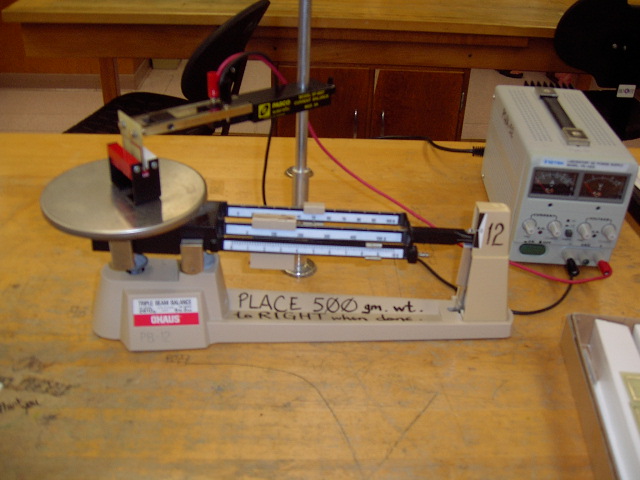
Equipment List:
Pan Balance
High current supply
Pasco Magnetic force apparatus
aluminum support rods
red and black bananas
One Gauss meter for the entire class (to verify your
calculated value for the magnetic field within your permanent magnet)
Introduction: A wire carrying a current will experience a force when subjected to an external magnetic field. In this lab, the external field is supplied by the red and white horseshoe shaped set of magnets provided in your kit. Your goal is to calculate the magnetic field within your permanent horseshoe magnet. To understand this lab, think of the forces acting on the magnet not the current element. By Newton's third law, the force on the current element is equal in magnitude to the force back on the magnet. The pan balance reads the normal force acting on the magnet. So there are three forces acting on the magnet: gravity, normal, and the magnetic force from the current carrying wire. With this knowledge the magnetic field within your magnet can be calculated.
Procedure: Set up your appartus as instructed. The readings taken from the pan balance must be done with great sensitvity and care. Do not exceed the maximum current value through your circuit elements or else they will burn and be ruined. The maximum current through any of the conductors is 5 amps. Take the data for at least five different lengths of the conductor.
Analysis: Directly compute the value of the magnetic field for all of your five or six measurements (five field values for five conductor lengths). Your answer should be in units of kilogauss (because that is the unit the meter will read). Find the average field magnitude and its uncertainty (the standard deviation of the mean). Compare your average field value to the Gauss meter reading. Does the meter value fall within the most probable range from your average and uncertainty? If so, you have "agreement". If not, consider in your conclusion what could have happened. Also, calculate the percent discrepancy between the meter value and your average value. You could get as much as twenty or thirty percent discrepancy (remember, the field in the magnet is not really uniform and will flucuate in value as the meter proble is moved about so stable spacial values are unlikely). Using a three step right hand rule, predict the direction of the magnetic field within the magnet (white to red or red to white).
And more: Use as many different lengths for your current element as is possible. Graph the magnetic force versus the length of the conductor and from the slope determine the value the magnetic field. Compare your value to the previous method. Which gives a more accurate result?
NOTE: The Gauss meter is expensive and the probe is very delicate.
It can be easily broken. Take great care in using it. Your instructor
should directly help in taking all measurements with the Gauss meter.

SF 40 1.2 cm
SF 37 2.2 cm
SF 39 3.2 cm
SF 38 4.2 cm
SF 41 6.4 cm
SF 42 8.4 cm